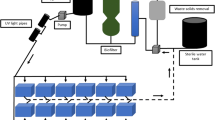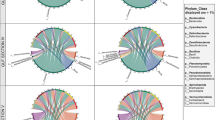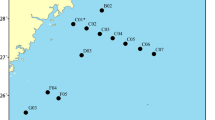Abstract
Molecular techniques were used to investigate the composition and ontogenetic development of the intestinal bacterial community in the marine herbivorous fish Kyphosus sydneyanus from the north eastern coast of New Zealand. Previous work showed that K. sydneyanus maintains an exclusively algivorous diet throughout post-settlement life and passes through an ontogenetic diet shift from a juvenile diet which is readily digestible to an adult diet high in refractory algal metabolites. Terminal restriction fragment length polymorphism (T-RFLP) analysis was used to investigate the relationship between bacterial community structure and fish size. Bacterial diversity was higher in posterior gut sections than anterior gut sections, and in larger fish than in smaller fish. Partial sequencing of bacterial 16S rDNA genes PCR amplified and cloned from intestine content samples was used to identify the phylogenetic affiliation of dominant gastrointestinal bacteria. Phylogenetic analysis of clones showed that most formed a clade within the genus Clostridium, with one clone associated with the parasitic mycoplasmas. No bacteria were specific to a particular intestinal section or size class of host, though some appeared more dominant than others and were established in smaller fishes. Clones closely related to C. lituseburense were particularly dominant in most intestine content samples. All bacteria identified in the intestinal samples were phylogenetically related to those possessing fermentative type metabolism. Short-chain fatty acids in intestinal fluid samples increased from 15.6 ± 2.1 mM in fish <100 mm to 51.6 ± 5.5 mM in fish >300 mm. The findings of this study support the hypothesis that the ontogenetic diet shift of K. sydneyanus is accompanied by an increase in the diversity of intestinal microbial symbionts capable of degrading refractory algal metabolites into short-chain fatty acids, which can then be assimilated by the host.




Similar content being viewed by others
References
ER Angert AE Brooks NR Pace (1996) ArticleTitlePhylogenetic analysis of Metabacterium polyspora clues to the evolutionary origin of daughter cell production in Epulopiscium species, the largest bacteria J Bacteriol 178 1451–1456 Occurrence Handle8631724
ER Angert KD Clements NR Pace (1993) ArticleTitleThe largest bacterium Nature 362 239–241 Occurrence Handle8459849
KA Bjorndal (1997) Fermentation in reptile and amphibians RI Mackie BI White (Eds) Gastrointestinal Microbiology Chapman and Hall New York 199–230
J Brosius TL Dull DD Sleeter HF Noller (1981) ArticleTitleGene organisation and primary structure of a ribosomal RNA operon fromEscherichia coli J Mol Biol 148 107–127 Occurrence Handle7028991
KD Clements (1991) ArticleTitleEndosymbiotic communities of two herbivorous labroid fishes, Odax cyanomelas and Odax pullus Mar Biol 109 223–230 Occurrence Handle10.1007/BF01319390
KD Clements (1997) Fermentation and gastrointestinal microorganisms in fishes RI Mackie BI White (Eds) Gastrointestinal Microbiology Chapman and Hall New York 156–198
KD Clements JH Choat (1993) ArticleTitleThe influence of season, ontogeny and tide on the diet of the temperate marine herbivorous fish Odax pullus (Odacidae) Mar Biol 117 213–220 Occurrence Handle10.1007/BF00345665
KD Clements JH Choat (1995) ArticleTitleFermentation in tropical marine herbivorous fishes Physiol Zool 68 355–378
KD Clements JH Choat (1997) ArticleTitleComparison of herbivory in the closely-related marine fish genera Girella and Kyphosus Mar Biol 127 579–586 Occurrence Handle10.1007/s002270050048
KD Clements VP Glesson M Slaytor (1994) ArticleTitleShort-chain fatty acid metabolism in temperate marine herbivorous fish J Comp Physiol B 164 372–377 Occurrence Handle10.1007/BF00302552
MH Clench JR Mathias (1995) ArticleTitleThe avian cecum: a review Wilson Bull 107 93–121
JR Cole B Chai TL Marsh RJ Farris Q Wang SA Kulam S Chandra DM McGarrell TM Schmidt GM Garrity JM Tiedje (2003) ArticleTitleThe Ribosomal Database Project (RDP-II): previewing a new autoaligner that allows regular updates and the new prokaryotic taxonomy Nucleic Acids Res 31 442–443 Occurrence Handle12520046
J Dunbar LO Ticknor CR Kruske (2001) ArticleTitlePhylogenetic specificity and reproducibility and new method for analysis of terminal restriction fragment profiles of 16S rRNA genes from bacterial communities Appl Environ Microbiol 67 190–197 Occurrence Handle11133445
L Fishelson WL Montgomery AAJ Myrberg (1985) ArticleTitleA unique symbiosis in the gut of tropical herbivorous surgeonfish Acanthuridae teleostei from the Red Sea Science 229 49–51
TA Hall (1999) ArticleTitleBioEdit: a user-friendly biological sequence alignment editor and analysis program for Windows 95/98/NT Nucl Acids Symp Ser 41 95–98
WE Holben P Williams M Saarinen LK Särkilahti JHA Apajalahti (2002) ArticleTitlePhylogenetic analysis of intestinal microflora indicates a novel Mycoplasmaphylotype in farmed and wild salmon Microb Ecol 44 175–185 Occurrence Handle12082453
JG Holt NR Krieg PHA Sneath JT Staley ST Williams (Eds) (1994) Bergey’s Manual of Determinative Bacteriology Williams and Wilkins Baltimore
DO Krause BP Dalrymple WJ Smith RI Mackie CS McSweeney (1999) ArticleTitle16S rDNA sequencing of Ruminococcus albus and Ruminococcus flavefaciensdesign of a signature probe and its application in adult sheep Microbiology 145 1797–1807 Occurrence Handle10439419
TL Marsh P Saxman J Cole J Tiedje (2000) ArticleTitleTerminal restriction fragment length polymorphism analysis program, a web-based research tool for microbial community analysis Appl Environ Microbiol 66 3616–3620 Occurrence Handle10919828
D Moran KD Clements (2002) ArticleTitleDiet and endogenous carbohydrases in the temperate marine herbivorous fishKyphosus sydneyanus J Fish Biol 60 1190–1203 Occurrence Handle10.1111/j.1095-8649.2002.tb01714.x
MI Morée JB Herrick MC Silva WC Ghiorse EL Madsen (1994) ArticleTitleQuantitative cell lysis of indigenous mircoorganisms and rapid extraction of microbial DNA from sediment Appl Environ Microbiol 60 1572–1580 Occurrence Handle8017936
DO Mountfort J Campbell KD Clements (2002) ArticleTitleHindgut fermentation in three species of marine herbivorous fish Appl Environ Microbiol 68 1374–1380 Occurrence Handle11872490
KE Nelson ML Thonney TK Woolston SH Zinder AN Pell (1998) ArticleTitlePhenotypic and phylogenetic characterization of ruminal tannin-tolerant bacteria Appl Environ Microbiol 64 3824–3830 Occurrence Handle9758806
AV Rake (1972) ArticleTitleIsopropanol preservation of biological samples for subsequent DNA extraction and reassociation studies Anal Biochem 48 365–368 Occurrence Handle4560810
DW Rimmer (1986) ArticleTitleChanges in diet and the development of microbial digestion in juvenile buffalo bream Kyphosus cornelii Mar Biol 92 443–448 Occurrence Handle10.1007/BF00392685
DW Rimmer WJ Wiebe (1987) ArticleTitleFermentative microbial digestion in herbivorous fishes J Fish Biol 31 229–236
JB Russell JL Rychlik (2001) ArticleTitleFactors that alter rumen microbial ecology Science 292 1119–1122 Occurrence Handle11352069
CE Stevens ID Hume (1995) Comparative Physiology of the Vertebrate Digestive System, 2nd ed Cambridge University Press New York
MT Suzuki SJ Giovannoni (1996) ArticleTitleBias caused by template annealing in the amplification of mixtures of 16S rRNA genes by PCR Appl Environ Microbiol 62 625–630 Occurrence Handle8593063
JD Thompson TJ Gibson F Plewniak F Jeanmougin DG Higgins (1997) ArticleTitleThe ClustalX-Windows interface: flexible strategies for multiple sequence alignment aided by quality analysis tools Nucleic Acids Res 25 4876–4882 Occurrence Handle10.1093/nar/25.24.4876 Occurrence Handle9396791
E Titus GA Ahearn (1988) ArticleTitleShort-chain fatty acid transport in the intestine of a herbivorous teleost J Exp Biol 135 77–94 Occurrence Handle2836545
E Titus GA Ahearn (1991) ArticleTitleTransintestinal acetate transport in a herbivorous teleost anion exchange at the basolateral membrane J Exp Biol 156 41–62
E Titus GA Ahearn (1992) ArticleTitleVertebrate gastrointestinal fermentation: transport mechanisms for volatile fatty acids Am J Physiol 262 R547–R553 Occurrence Handle1566920
FV Wintzingerode UB Gobel E Stackebrandt (1997) ArticleTitleDetermination of microbial diversity on environmental samples: pitfalls of PCR-based rRNA analysis FEMS Microbiol Rev 21 213–229 Occurrence Handle9451814
JH Zar (1999) Biostatistical Analysis, 4th ed Prentice Hall Upper Saddle River, NJ
Acknowledgments
This research was funded by a Marsden Grant from the Royal Society of New Zealand. We thank D. Mountfort for help with SCFA analysis, I. Pasch and C. Brown for assistance in the laboratory, D. Saul for assistance with the phylogenetic analysis, M. Birch and B. Doak for help in the field, and E. Angert for helpful comments on the manuscript.
Author information
Authors and Affiliations
Corresponding author
Rights and permissions
About this article
Cite this article
Moran, D., Turner, S. & Clements, K. Ontogenetic Development of the Gastrointestinal Microbiota in the Marine Herbivorous Fish Kyphosus sydneyanus. Microb Ecol 49, 590–597 (2005). https://doi.org/10.1007/s00248-004-0097-4
Received:
Accepted:
Published:
Issue Date:
DOI: https://doi.org/10.1007/s00248-004-0097-4




